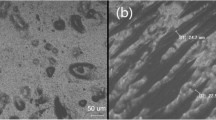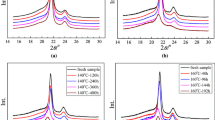Abstract
Silane-crosslinked polyethylene (Si-XLPE) is the first candidate polymer that can be used in the photovoltaic systems connection cables because its resistance to the weathering conditions. The idea of the carried out work in this paper is how we can benefit from the existing weathering conditions that looked to be similar to those necessary in the silane-crosslinking process of polyethylene to enhance the crosslinking capability? The adopted methodology consists to conduct a long-term cyclic accelerated weathering aging in the QUV aging test cell on the extruded silane-grafted polyethylene films (cross-linkable polyethylene). The possible crosslinking behavior and the photo and thermo-oxidation degradation were assessed by macroscopic (Hot-Set-Test and mechanical properties) and microscopic (Fourier Transform Infrared Spectroscopy (FTIR)) technics. The obtained results highlight that the applied cyclic weathering aging leads to an outcome crosslinking reaction. The crosslinking degree increases progressively with aging time leading to an elastic behavior of the polymer. More the crosslinking degree increases the Hot-Set-Test elongation decreases. The macroscopic observations agree well with the FTIR measurements where we have noticed big changes in the digital fingerprint of the material. The changes in the digital fingerprint are caused by the transformation of silane into Si–O–Si links. The absorption band of Si–O–Si link at 1030 cm−1 increases with the aging time increase. Besides this, it is evidenced from our study that mechanical properties and carbonyl index behave in a very similar way (an increase in the former leads to the decrease in the latter in each case) which put in evidence that the same mechanisms are responsible for both behaviors. The probable scenario for this behavior is that the oxidation process leads to a chain session process. The chain session has a dramatic effect on the mechanical properties that decrease in a fast way. The overall conclusion is that the possible crosslinking is done in three steps: initiation, propagation, and termination.
Access this chapter
Tax calculation will be finalised at checkout
Purchases are for personal use only
Similar content being viewed by others
References
Ahmed, G.S., Gilbert, M., Mainprize, S. & Rogerson, M. (2009). FTIR analysis of silane grafted high density polyethylene. Plastics, Rubber and Composites, 38(1), 13–20.
Antonucci, J. M., Dickens, S. H., Fowler, B. O. & Xu, H. H. K. (2005), Chemistry of silanes: interfaces in dental polymers and composites, Journal of Research of the National Institute of Standards and Technology, 110(5), 541–558.
Blivet, C., Larché, J. F., Israëli,Y. & Bussière, P. O. (2022). Non-Arrhenius behavior: influence of the crystallinity on lifetime predictions of polymer materials used in the cable and wire industries. Polymer Degradation and Stability, 199, 10989079.
Boukezzi, L. & Boubakeur, A. (2018). Effect of thermal aging on the electrical characteristics of XLPE for HV cables. Transactions on Electrical and Electronic Materials, 19(5), 341–355.
Boukezzi, L., Rondot, S., Jbara, O., Ghoneim, S. S. M., Mohamed Abdelwahab, S. A. & Boubakeur, A. (2022). Effect of isothermal conditions on the charge trapping/detrapping parameters in e-beam irradiated thermally aged XLPE insulation in SEM. Materials, 15, 1918.
Celina, M. & George, G. A. (1995). Characterization and degradation studies of peroxide and silane crosslinked polyethylene. Polymer Degradation and Stability, 48, 297–312.
Chabira, S. F., Sebaa, M. & G’sell, C. (2008). Influence of climatic ageing on the mechanical properties and the microstructure of low-density polyethylene films. Journal of Applied Polymer Science, 110, 2516–2524.
Chabira, S. F. et al. (2019). Impact of the structural changes on the fracture behavior of naturally weathered low-density polyethylene (LDPE) films. Journal of Macromolecular Science, Part B, 58(2), 400–424.
Davis, A. & Sims, D. (1983). Weathering of polymer . Ultraviolet radiation. London : Applied science publishers.
De Melo, R. P., Aguiar, V. de O. & Marques, M. de F. V. (2015). Silane crosslinked polyethylene from different commercial PE’s: influence of comonomer, catalyst type and evaluation of HLPB as crosslinking coagent. Materials Research, 18, 313–319.
Gulmine , J. V., Janissek , P. R., Heise , H. M. & Akcelrud, L. (2003). Degradation profile of polyethylene after artificial accelerated weathering. Polymer Degradation and Stability, 79, 385–397.
Hjertberc, T., Palmlf, M. & Sultan, B. A. (1991). Chemical reactions in crosslinking of copolymers of ethylene and vinyltrimethoxy silane, Journal of Applied Polymer Science, 42, 1185–1192.
IEC60811-1-2 2001. (2001). Common test methods for insulating and sheathing materials of electric and optical cables—Part 2–1: Methods specific to elastomeric compounds—Ozone resistance, hot set and mineral oil immersion tests.
IEC 60502. (1998). Power cables extruded insulation and their accessories for rated voltages from 1 kV (Um=1.2 kV) up to 30 kV (Um=36 kV).
Morshedian, J. & Hoseinpour, P. (2009). Polyethylene crosslinking by two-step silane method: a review. Iranian Polymer Journal, 18, 103–128.
Mostofi Sarkari, N., Mohseni, M. & Ebrahimi, M. (2021). Examining impact of vapor-induced crosslinking duration on dynamic mechanical and static mechanical characteristics of silane-water crosslinked polyethylene compound. Polymer Testing, 93,106933.
Nóbrega, A. M., Martinez, M. L. B. & De Queiroz, A. A. A. (2013). Investigation and Analysis of Electrical Aging of XLPE Insulation for Medium Voltage Covered Conductors Manufactured in Brazil. IEEE Transactions on Dielectrics and Electrical Insulation,20(2), 628–640.
Plesa, I., Notingher, P. V., Stancu , C., Wiesbrock, F. & Schlögl, S. (2019). Polyethylene nanocomposites for power cable insulations. Polymers, 11(24), 1–61.
Rajagopalan, N., & Khanna, A. S. (2014). Effect of methyltrimethoxy silane modification on yellowing of epoxy coating on UV (B) exposure. Journal of Coatings, 2014, 515470.
Rodriguez, A. K., Mansoor, B., Ayoub, G., Colin, X. & Benzerga, A. A. (2020). Effect of UV-aging on the mechanical and fracture behavior of low-density polyethylene. Polymer Degradation and Stability, 180, 109185.
Sarkari, N. M., Mohseni, M. & Ebrahimi, M. (2021). Examining impact of vapor-induced crosslinking duration on dynamic mechanical and static mechanical characteristics of silane-water crosslinked polyethylene compound. Polymer Testing, 93, 106933.
Shimada, A. & Sugimoto, M. (2013). Degradation distribution in insulation materials of cables by accelerated thermal and radiation ageing. IEEE Transactions on Dielectrics and Electrical Insulation, 20(6), 2107–2116.
Sirisinha, K. & Chimdist, S. (2006). Comparison of techniques for determining crosslinking in silane-water crosslinked materials. Polymer Testing, 25, 518–526.
Sirisinha, K. & Kamphunthong, W. (2009). Rheological analysis as a means for determining the silane crosslink network structure and content in crosslinked polymer composites. Polymer Testing, 28, 636–641.
Tamboli, S. M., Mhaskie, S. T. & kale, D. D. Crosslinked polyethelene. (2004). Indian Journal of Chemical Technology, 11, 853–864.
Thomas, J. et al. (2019). Advances in cross-linked polyethylene-based nanocomposites for high voltage engineering applications: a critical review, Industrial and Engineering Chemistry Research, 58, 20863–20879.
Xu, A., Roland, S. & Colin, X. (2020). Physico-chemical characterization of the blooming of Irganox 1076® antioxidant onto the surface of a silane-crosslinked polyethylene. Polymer Degradation and Stability, 171, 109046.
Author information
Authors and Affiliations
Corresponding author
Editor information
Editors and Affiliations
Rights and permissions
Copyright information
© 2022 The Author(s), under exclusive license to Springer Nature Switzerland AG
About this paper
Cite this paper
Afeissa, S., Boukezzi, L., Bessissa, L., Loucif, A. (2022). A Possible Crosslinking Behavior of Silane-Crosslinkable Polyethylene Under Cyclic Accelerated Weathering Aging. In: Vaseashta, A., Achour, M.E., Mabrouki, M., Fasquelle, D., Tachafine, A. (eds) Proceedings of the Sixth International Symposium on Dielectric Materials and Applications (ISyDMA’6). Springer, Cham. https://doi.org/10.1007/978-3-031-11397-0_13
Download citation
DOI: https://doi.org/10.1007/978-3-031-11397-0_13
Published:
Publisher Name: Springer, Cham
Print ISBN: 978-3-031-11396-3
Online ISBN: 978-3-031-11397-0
eBook Packages: Physics and AstronomyPhysics and Astronomy (R0)




